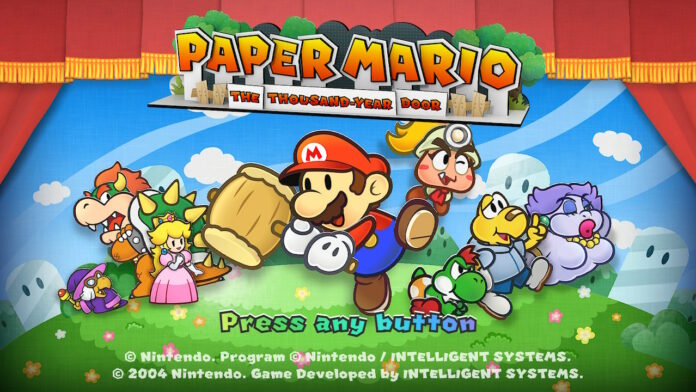Starting with the original Paper Mario (2000) on the N64, the quirky, turn-based RPG spin-off series has gotten an exclusive entry on every mainline Nintendo console since. Despite the fact that every Paper Mario game that has been released so far (including the controversial Sticker Star) received generally positive reviews from critics, none have come close to the fan-favorite popularity of Paper Mario: The Thousand-Year Door (2004) from the GameCube. Rumors of an HD remaster of TTYD have circulated online for quite a while now, but Nintendo greatly exceeded expectations when they officially announced late last year that a full-blown remake for Switch was set for release in 2024 to celebrate the 20th anniversary of the original.
Before getting any deeper into this preview, I feel like I should come clean and admit that although I’ve heard a lot about the game from being an active participant in various Nintendo communities, I have never actually experienced the original Paper Mario: The Thousand-Year Door for myself. However, having now gotten to play through the first three chapters of the Switch remake (which confusingly shares the same name as the GameCube version since Nintendo uses subtitles like “HD” and “Deluxe” for ports and remasters rather than remakes), I can confidently say I finally understand what all the fuss is about.
Paper Mario: The Thousand-Year Door makes further sense of why GameCube games aren’t included as part of the Nintendo Switch Online + Expansion Pack despite the constant demand. As a fan, of course something like that would be nothing short of a dream come true, but logistically speaking, the GameCube is just old enough to where Nintendo can re-release some of the games individually at full price. This first became apparent with the recent HD remasters of Metroid Prime and Pikmin 1+2, but the amount of quality care that was put into the upcoming TTYD remake has fully convinced me that this was the better decision overall. Even though it’s essentially the same game as it was 20 years ago, the changes that have been made makes it feels like something brand new, whether you’re playing it for the first time or revisiting the classic adventure once again.

Although the core of the game remains the same, there are a few quality-of-life changes and tweaks that stood out to me when comparing the remake to the original side-by-side. Not only has the menu gotten a complete visual overhaul, there are now a few additional options, including an art gallery (which features a look at concept art) and a sound gallery (functioning as a music player). The contents of these galleries are separated by chapter, and in order to unlock them, you must not only finish the chapter and obtain the Crystal Star, but also find all the Star Pieces (for the art gallery) and Shine Sprites (for the sound gallery) within said chapter. Outside of the menu, there is now a convenient quick wheel to easily swap between party members, some of the badges have been renamed (i.e. Attack FX P is now the sound of Peach giggling instead of Attack FX G), new badges are introduced (including one that changes the background music to the original GameCube tracks), and characters only appear on the main title screen after they join your party (only Mario is there when you first start the game).
The modern graphics of the remake really makes the game feel fresh and new while still maintaining the charm and identity of the original. While some may not be fond of the more glossy, reflective look of the environment, and the subtle white outline on the edges of the characters makes them look more like cardboard rather than paper (not to be confused with the thick white borders of subsequent Paper Mario games), I was thoroughly impressed with the art direction and believe that the visuals alone make it worth replaying for fans of the original. However, one notable downside is that the game now runs at 30fps instead of 60fps like it did on GameCube. As someone that is very sensitive to frame-rate (it’s all I can think about while playing 3-4 player split-screen in Mario Kart 8 Deluxe) I surprisingly found it to mostly be a non-issue in this particular case.


One of the ways that TTYD stands out from the more recent Paper Mario titles is the unique cast of characters that really makes the world feel alive and lived in. The witty, well-written dialogue had me actually wanting to interact and talk with every character that I came across while exploring, which, for me personally, is a rarity when it comes to RPGs. Kensuke Tanabe, the producer of the Paper Mario series since Super Paper Mario (2007), has stated that Mario creator, Shigeru Miyamoto, only wants the developers to use already established characters as much as possible, and that toads shouldn’t “graphically represent individual characteristics.” Since TTYD defies this, Nintendo remaking the game brings hope for the series’ future.
If you were to tell me in the early days of the Switch that The Thousand-Year Door would get a remake before a port of Paper Mario: Color Splash (one of the last few remaining exclusive Wii U games), I would have thought you were crazy. But in a world where even Super Mario RPG got a faithful remake from Square Enix, I wouldn’t be surprised if a revival of Mario’s other RPG series, Mario & Luigi, was next in line (even though the series developer AlphaDream unfortunately filed for bankruptcy in 2019). As the life cycle of the current console generation comes to a close, I can’t wait to see what Nintendo does next.
If the first three chapters are anything to go by, the Nintendo Switch remake of Paper Mario: The Thousand-Year Door is the definitive way to play the beloved GameCube classic. So far, it seems as though everything people loved about the original remains faithful and unchanged. With updated graphics, a remastered soundtrack, quality-of-life changes, and more, what’s widely considered to be one of the best games in the Paper Mario series has now been made even better. Make sure to keep an eye out for our full review before Paper Mario: The Thousand-Year Door launches for Nintendo Switch on 23 May 2024.
A copy of Paper Mario: The Thousand-Year Door for preview purposes was provided by Nintendo UK.
Related
mynintendonews.com







